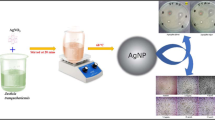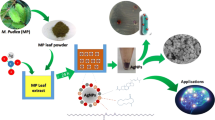Abstract
Herein, we have used a non-hazardous and environment-friendly green approach for the PEGylation of silver nanoparticles (PEGylated AgNPs) using an aqueous extract of Berginia Ciliata. The PEGylated AgNPs are also compared with non-PEGylated pristine silver nanoparticles (p-AgNPs) for physicochemical, morphological, and biological properties using multiple characterization techniques and biological assays. The detailed characterization investigation not only confirms the successful capping of PEG but also reveals that PEG highly influences the morphology, yield, and dispersibility of the AgNPs. Such physicochemically altered properties may have also resulted in different biological properties as the PEGylated AgNPs result in higher antioxidant and antileishmanial properties as compared to pristine AgNPs. However, comparatively lower antibacterial and enzyme inhibition potentials are observed for PEGylated AgNPs. Furthermore, in vitro blood compatibility studies reveal the bio-safe nature of both the PEGylated and pristine AgNPs at the tested concentrations. Our study thus concludes that the green synthesis approach could be successfully utilized for PEGylation of metallic NPs of pharmacological importance.
Graphical abstract















Similar content being viewed by others
References
J. Ihsan, M. Farooq, M.A. Khan et al., Synthesis, characterization, and biological screening of metal nanoparticles loaded gum acacia microgels. Microsc. Res. Tech. 84, 1673–1684 (2021). https://doi.org/10.1002/jemt.23726
A.K. Keshari, R. Srivastava, P. Singh et al., Antioxidant and antibacterial activity of silver nanoparticles synthesized by Cestrum nocturnum. J. Ayurveda Integr. Med. 11, 37–44 (2020). https://doi.org/10.1016/j.jaim.2017.11.003
E. Haggag, A. Elshamy, M. Rabeh et al., Antiviral potential of green synthesized silver nanoparticles of Lampranthus coccineus</em> and <em>Malephora lutea</em></p>. Int. J. Nanomedicine 14, 6217–6229 (2019). https://doi.org/10.2147/IJN.S214171
S. Andra, S.K. Balu, J. Jeevanandam, M. Muthalagu, Emerging nanomaterials for antibacterial textile fabrication. Naunyn Schmiedebergs Arch. Pharmacol. 394, 1355–1382 (2021). https://doi.org/10.1007/s00210-021-02064-8/Published
Q.U.A. Fatima, N. Ahmed, B. Siddiqui et al., Enhanced antimicrobial activity of silver sulfadiazine cosmetotherapeutic nanolotion for burn infections. Cosmetics 9, 93 (2022). https://doi.org/10.3390/cosmetics9050093
M.I. Khan, A. Mazumdar, S. Pathak et al., Biogenic Ag/CaO nanocomposites kill Staphylococcus aureus with reduced toxicity towards mammalian cells. Colloids Surf. B Biointerfaces 189, 110846 (2020). https://doi.org/10.1016/j.colsurfb.2020.110846
R. Akram, M.D. Khan, C. Zequine et al., Cobalt sulfide nanoparticles: Synthesis, water splitting and supercapacitance studies. Mater. Sci. Semicond. Process. 109, 104925 (2020). https://doi.org/10.1016/J.MSSP.2020.104925
V. Bastos, J.M.P. Ferreira de Oliveira, D. Brown et al., The influence of Citrate or PEG coating on silver nanoparticle toxicity to a human keratinocyte cell line. Toxicol. Lett. 249, 29–41 (2016). https://doi.org/10.1016/j.toxlet.2016.03.005
S. Jegatheeswaran, M. Sundrarajan, PEGylation of novel hydroxyapatite/PEG/Ag nanocomposite particles to improve its antibacterial efficacy. Mater. Sci. Eng. C 51, 174–181 (2015). https://doi.org/10.1016/j.msec.2015.02.012
A. Nicosia, A. Abbadessa, F. Vento et al., Silver nanoparticles decorated with PEGylated porphyrins as potential theranostic and sensing agents. Materials (Basel) 14, 2764 (2021). https://doi.org/10.3390/ma14112764
P.S. Sadalage, R.V. Patil, D.V. Havaldar et al., Optimally biosynthesized, PEGylated gold nanoparticles functionalized with quercetin and camptothecin enhance potential anti-inflammatory, anti-cancer and anti-angiogenic activities. J Nanobiotechnology 19, 84 (2021). https://doi.org/10.1186/s12951-021-00836-1
A. Mosaddik, V. Ravinayagam, S. Elaanthikkal et al., Development and Use of Polymeric Nanoparticles for the Encapsulation and Administration of Plant Extracts, in Natural Products as Source of Molecules with Therapeutic Potential. (Springer International Publishing, Cham, 2018), pp.391–463
P.P. Tumkur, N.K. Gunasekaran, B.R. Lamani et al., Cerium oxide nanoparticles: synthesis and characterization for biosafe applications. Nanomanufacturing 1, 176–189 (2021). https://doi.org/10.3390/nanomanufacturing1030013
B. Armendáriz-Barragán, N. Zafar, W. Badri et al., Plant extracts: from encapsulation to application. Expert Opin. Drug Deliv. 13, 1165–1175 (2016). https://doi.org/10.1080/17425247.2016.1182487
S. Jevševar, M. Kunstelj, V.G. Porekar, PEGylation of therapeutic proteins. Biotechnol. J. 5, 113–128 (2010). https://doi.org/10.1002/biot.200900218
F.M. Veronese, G. Pasut, PEGylation, successful approach to drug delivery. Drug Discov. Today 10, 1451–1458 (2005). https://doi.org/10.1016/S1359-6446(05)03575-0
I. Yadav, S.D. Purohit, H. Singh et al., A highly transparent tri-polymer complex in situ hydrogel of HA, collagen and four-arm-PEG as potential vitreous substitute. Biomed. Mater. 16, 065018 (2021). https://doi.org/10.1088/1748-605X/ac2714
Z. Hussain, S. Khan, M. Imran et al., PEGylation: a promising strategy to overcome challenges to cancer-targeted nanomedicines: a review of challenges to clinical transition and promising resolution. Drug Deliv. Transl. Res. 9, 721–734 (2019). https://doi.org/10.1007/s13346-019-00631-4
A.S. Karakoti, S. Das, S. Thevuthasan, S. Seal, PEGylated inorganic nanoparticles. Angew Chemie Int Ed 50, 1980–1994 (2011). https://doi.org/10.1002/anie.201002969
S. Naz, S.T.B. Kazmi, M. Zia, CeO 2 nanoparticles synthesized through green chemistry are biocompatible: In vitro and in vivo assessment. J. Biochem. Mol. Toxicol. 33, (2019). https://doi.org/10.1002/jbt.22291
S. Hasan, A review on nanoparticles: their synthesis and types. Res. J. Recent. Sci. 2277, 2502 (2015)
S.A. Gaddam, V.S. Kotakadi, G.K. Subramanyam et al., Multifaceted phytogenic silver nanoparticles by an insectivorous plant Drosera spatulata Labill var. bakoensis and its potential therapeutic applications. Sci. Rep. 11, 21969 (2021). https://doi.org/10.1038/s41598-021-01281-8
S.K. Srikar, D.D. Giri, D.B. Pal et al., Green synthesis of silver nanoparticles: a review. Green Sustain. Chem. 06, 34–56 (2016). https://doi.org/10.4236/gsc.2016.61004
K.O. Iwuozor, L.A. Ogunfowora, I.P. Oyekunle, Review on sugarcane-mediated nanoparticle synthesis: a green approach. Sugar Tech 24, 1186–1197 (2022). https://doi.org/10.1007/s12355-021-01038-7
K. Kraśniewska, S. Galus, M. Gniewosz, Biopolymers-based materials containing silver nanoparticles as active packaging for food applications–a review. Int. J. Mol. Sci. 21, 698 (2020). https://doi.org/10.3390/ijms21030698
A.H. Korayem, N. Tourani, M. Zakertabrizi et al., A review of dispersion of nanoparticles in cementitious matrices: nanoparticle geometry perspective. Constr. Build. Mater. 153, 346–357 (2017). https://doi.org/10.1016/j.conbuildmat.2017.06.164
Z. Haris, I. Ahmad, Green synthesis of silver nanoparticles using Moringa oleifera and its efficacy against gram-negative bacteria targeting quorum sensing and biofilms. J. Umm Al-Qura Univ. Appl. Sci. 10, 156–167 (2024). https://doi.org/10.1007/s43994-023-00089-8
S. Faisal, M.A. Khan, H. Jan et al., Edible mushroom (Flammulina velutipes) as biosource for silver nanoparticles: from synthesis to diverse biomedical and environmental applications. Nanotechnology 32, 065101 (2021). https://doi.org/10.1088/1361-6528/abc2eb
S. Baliyan, R. Mukherjee, A. Priyadarshini et al., Determination of antioxidants by DPPH radical scavenging activity and quantitative phytochemical analysis of Ficus religiosa. Molecules 27, 1326 (2022). https://doi.org/10.3390/molecules27041326
T.R. Kyriakides, A. Raj, T.H. Tseng et al., Biocompatibility of nanomaterials and their immunological properties. Biomed. Mater. 16, 042005 (2021). https://doi.org/10.1088/1748-605X/abe5fa
D. Jagadeesh, K. Prashantha, R. Shabadi, Star-shaped sucrose-capped CaO nanoparticles from Azadirachta indica : a novel green synthesis. Inorg. Nano-Metal Chem. 47, 708–712 (2017). https://doi.org/10.1080/15533174.2016.1212231
S. Hemmati, A. Rashtiani, M.M. Zangeneh et al., Green synthesis and characterization of silver nanoparticles using Fritillaria flower extract and their antibacterial activity against some human pathogens. Polyhedron 158, 8–14 (2019). https://doi.org/10.1016/j.poly.2018.10.049
M.U. Zahid, M.A. Khan, U. Ahmad et al., A Comparative Study of PEGylated Cobalt Oxide Nanoparticles (Co3O4-NPs) and Cobalt Sulfide Nanoparticles (Co9S8-NPs) for Biological and Photocatalytic Applications. Bionanoscience (2024). https://doi.org/10.1007/s12668-024-01322-2
M.A. Khan, M.A.R. Siddique, M. Sajid et al., A Comparative Study of Green and Chemical Cerium Oxide Nanoparticles (CeO2-NPs): From Synthesis, Characterization, and Electrochemical Analysis to Multifaceted Biomedical Applications. Bionanoscience 13, 667–685 (2023). https://doi.org/10.1007/s12668-023-01114-0
A.U. Khan, H.U. Khan, M.S.O. Alhar et al., Antimicrobial, antioxidant, and antileishmanial activity of Tavernier glabra mediated ZnO NPs and Fe2O3 NPs. Inorg. Chem. Commun. 148, 110297 (2023). https://doi.org/10.1016/j.inoche.2022.110297
H. Aziz, A. Saeed, F. Jabeen et al., Design, synthesis, in vitro anti-oxidant evaluation, α-amylase inhibition assay, and molecular docking analysis of 2-(2-benzylidenehydrazinyl)-4,4-diphenyl-1H-imidazol-5(4H)-ones. J. Mol. Struct. 1278, 134924 (2023). https://doi.org/10.1016/j.molstruc.2023.134924
S. Das, J.M. Dowding, K.E. Klump et al., Cerium oxide nanoparticles: applications and prospects in nanomedicine. Nanomedicine 8, 1483–1508 (2013). https://doi.org/10.2217/nnm.13.133
S. Jan, M.R. Khan, U. Rashid, J. Bokhari, Assessment of antioxidant potential, total phenolics and flavonoids of different solvent fractions of Monotheca buxifolia fruit. Osong Pub. Health Res. Perspect. 4, 246–254 (2013). https://doi.org/10.1016/j.phrp.2013.09.003
H. Ullah, J. Ihsan, R.M.K. Mohamed et al., Bionanocomposite scaffolds based on MnS-nanorods loaded acacia-Senegal-gum hydrogels: fabrication, characterization and biological evaluation. Bioact. Carbohydrates Diet. Fibre 30, 100368 (2023). https://doi.org/10.1016/j.bcdf.2023.100368
M. Farooq, J. Ihsan, R.M.K. Mohamed et al., Highly biocompatible formulations based on Arabic gum Nano composite hydrogels: Fabrication, characterization, and biological investigation. Int. J. Biol. Macromol. 209, 59–69 (2022). https://doi.org/10.1016/j.ijbiomac.2022.03.162
R. Balasubramanian, B. Kim, S.L. Tripp et al., Dispersion and stability studies of resorcinarene-encapsulated gold nanoparticles. Langmuir 18, 3676–3681 (2002). https://doi.org/10.1021/la0156107
B.I. Kharisov, H.V.R. Dias, O.V. Kharissova et al., Solubilization, dispersion and stabilization of magnetic nanoparticles in water and non-aqueous solvents: recent trends. RSC Adv. 4, 45354–45381 (2014). https://doi.org/10.1039/C4RA06902A
V. Kumar, S. Singh, B. Srivastava et al., Green synthesis of silver nanoparticles using leaf extract of Holoptelea integrifolia and preliminary investigation of its antioxidant, anti-inflammatory, antidiabetic and antibacterial activities. J. Environ. Chem. Eng. 7, 103094 (2019). https://doi.org/10.1016/j.jece.2019.103094
R.Y. Ghareeb, H. Alfy, A.A. Fahmy et al., Utilization of Cladophora glomerata extract nanoparticles as eco-nematicide and enhancing the defense responses of tomato plants infected by Meloidogyne javanica. Sci. Rep. 10, 19968 (2020). https://doi.org/10.1038/s41598-020-77005-1
S.O. Aisida, K. Ugwu, P.A. Akpa et al., Biosynthesis of silver nanoparticles using bitter leave (Veronica amygdalina) for antibacterial activities. Surf. Interfaces 17, 100359 (2019). https://doi.org/10.1016/j.surfin.2019.100359
J. Laloy, V. Minet, L. Alpan et al., Impact of silver nanoparticles on haemolysis, platelet function and coagulation. Nanobiomedicine 1, 4 (2014). https://doi.org/10.5772/59346
F. Niknejad, M. Nabili, R. DaieGhazvini, M. Moazeni, Green synthesis of silver nanoparticles: another honor for the yeast model Saccharomyces cerevisiae. Curr. Med. Mycol. 1, 17–24 (2015). https://doi.org/10.18869/acadpub.cmm.1.3.17
W.R. Rolim, J.C. Pieretti, D.L.S. Renó et al., Antimicrobial activity and cytotoxicity to tumor cells of nitric oxide donor and silver nanoparticles containing PVA/PEG films for topical applications. ACS Appl. Mater. Interfaces 11, 6589–6604 (2019). https://doi.org/10.1021/acsami.8b19021
Y. Sakata, S. Shiraishi, M. Otsuka, A novel white film for pharmaceutical coating formed by interaction of calcium lactate pentahydrate with hydroxypropyl methylcellulose. Int. J. Pharm. 317, 120–126 (2006). https://doi.org/10.1016/j.ijpharm.2006.02.058
M. Hafeez, R. Shaheen, B. Akram et al., Green synthesis of cobalt oxide nanoparticles for potential biological applications. Mater. Res. Express 7, 025019 (2020). https://doi.org/10.1088/2053-1591/ab70dd
M.D. Mauricio, S. Guerra-Ojeda, P. Marchio et al., Nanoparticles in medicine: a focus on vascular oxidative stress. Oxid. Med. Cell. Longev. 2018, 1–20 (2018). https://doi.org/10.1155/2018/6231482
C. Vanlalveni, S. Lallianrawna, A. Biswas et al., Green synthesis of silver nanoparticles using plant extracts and their antimicrobial activities: a review of recent literature. RSC Adv. 11, 2804–2837 (2021). https://doi.org/10.1039/D0RA09941D
A. Ahmad, S. Ullah, F. Syed et al., Biogenic metal nanoparticles as a potential class of antileishmanial agents: mechanisms and molecular targets. Nanomedicine 15, 809–828 (2020). https://doi.org/10.2217/nnm-2019-0413
M. Azim, S.A. Khan, S. Ullah et al., Therapeutic advances in the topical treatment of cutaneous leishmaniasis: a review. PLoS Negl. Trop. Dis. 15, e0009099 (2021). https://doi.org/10.1371/journal.pntd.0009099
J.R. Fanti, F. Tomiotto-Pellissier, M.M. Miranda-Sapla et al., Biogenic silver nanoparticles inducing Leishmania amazonensis promastigote and amastigote death in vitro. Acta Trop. 178, 46–54 (2018). https://doi.org/10.1016/j.actatropica.2017.10.027
Funding
The research project did not receive external funding.
Author information
Authors and Affiliations
Contributions
B.Q carried out the experimental work, analysed the data, and wrote the manuscript. M.A.K. perceived the idea, wrote and reviewed the manuscript. H.T, M.U.Z, H.A.A, S.J.H and U.A., assisted in the experimental work, resources, data and characterization analysis. S.A.I.B supervised the project. The authors B.Q and M.A.K contributed equally to this work.
Corresponding authors
Ethics declarations
Ethical approval
Not applicable.
Conflict of interest
The authors declare no competing interests.
Rights and permissions
Springer Nature or its licensor (e.g. a society or other partner) holds exclusive rights to this article under a publishing agreement with the author(s) or other rightsholder(s); author self-archiving of the accepted manuscript version of this article is solely governed by the terms of such publishing agreement and applicable law.
About this article
Cite this article
Qadeer, B., Khan, M.A., Tariq, H. et al. PEGylation of silver nanoparticles via Berginia Ciliata aqueous extract for biological applications. emergent mater. (2024). https://doi.org/10.1007/s42247-024-00727-9
Received:
Accepted:
Published:
DOI: https://doi.org/10.1007/s42247-024-00727-9




